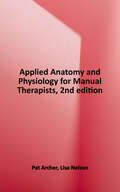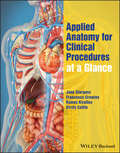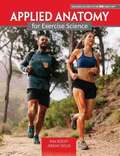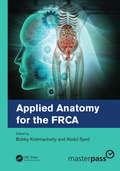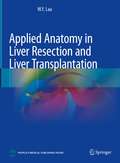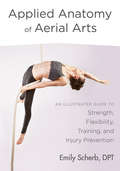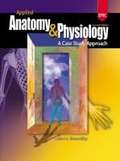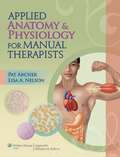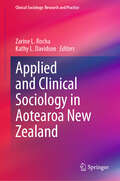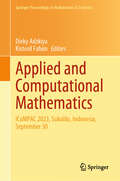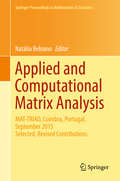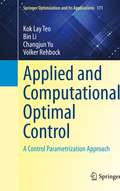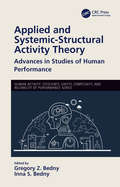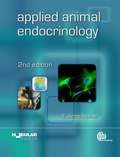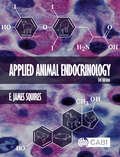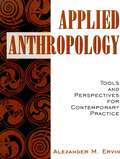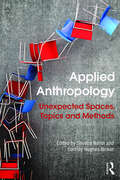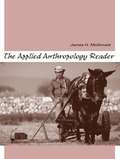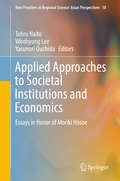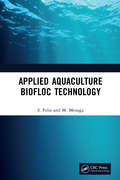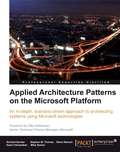- Table View
- List View
Applied Anatomy and Physiology for Manual Therapists
by Patricia A. Archer Lisa A. NelsonNot many textbooks can make critical anatomy and physiology (A & P) information engaging and accessible for massage therapy learners, but Applied Anatomy & Physiology for Manual Therapists pulls it off beautifully. This premier textbook explores everything manual therapy students need to know about A & P-in ways they can easily understand and apply to their hands-on work. Uniquely relevant and engaging Applied Anatomy & Physiology for Manual Therapists makes A & P principles personally meaningful for students by answering the questions "Why is it critical for me to learn this information?" and "How will it help me become a better manual therapist?" Crucial for safe and informed practice This trusted resource dives deep into need-to-know content, explaining the benefits, effects, indications, and contraindications of specific forms of manual therapy-preparing students to treat clients safely and effectively. <p><p>Practical details to enhance retention of A & P principles: Each chapter contains engaging, classroom-tested content to improve retention of A & P knowledge from classroom to clinic: Manual Therapy Applications highlight subjects most relevant to students' future profession, such as the intricacies of the myofascial network. Pathology Alerts describe common conditions encountered in manual therapy and ways the body systems respond to treatment. BTW boxes contain intriguing A & P facts that deepen students' understanding. What Do You Think? questions bridge the gaps between A & P concepts and manual therapy. Complimentary student resources available. See inside cover for details. Book jacket.
Applied Anatomy for Anaesthesia and Intensive Care
by Andy Georgiou FRCA DICM EDIC FFICM Chris Thompson FRCA EDRA James Nickells Frca Andy Georgiou FRCA DICM EDIC FFICM Chris Thompson FRCA EDRAApplied Anatomy for Anaesthesia and Intensive Care is an invaluable tool for trainee and practiced anaesthetists and intensive care physicians seeking to learn, revise and develop their anatomical knowledge and procedural skills. Concise textual descriptions of anatomy are integrated with descriptions of procedures that are frequently performed in anaesthesia and intensive care, e.g. nerve blocks, focussed echo, lung ultrasound, vascular access procedures, front of neck airway access and chest drainage. The text is supported by over 200 high-quality, colour, anatomical illustrations, which are correlated with ultrasound, fibreoptic and radiological images, allowing the reader to easily interpret nerve block sonoanatomy, airway fibreoptic images and important features on CT and MRI scans. Useful mnemonics and easily reproducible sketch diagrams make this an essential resource for anyone studying towards postgraduate examinations in anaesthesia and intensive care medicine.
Applied Anatomy for Clinical Procedures at a Glance (At a Glance)
by Jane Sturgess Francesca Crawley Ramez Kirollos Kirsty CattleApplied Anatomy for Clinical Procedures at a Glance is a concise resource combining high-quality images and step-by-step instructions to provide expert guidance on the major core training pathways in medicine, surgery and anaesthesia. Written by an experienced team of Foundation Training programme directors and clinical skills examiners, this unique revision and learning guide aligns with training pathways rather than anatomical area to support Foundation doctors and core trainees master these vital clinical procedures. Succinct yet thorough descriptions of each procedure include photographs of surface anatomy, line diagrams of the anatomy, instructions on the procedural techniques, and practical tips for performing the procedures safely whilst minimising risks of complications. All major aspects of Foundation procedures and Core training in applied anatomy are covered, including catheterisation, ECGs, central venous cannulation, basic suturing and anastomotic techniques, endotracheal intubation, epidural injection and spinal injection, defibrillation, and many others. Helps Foundation doctors and Core trainees apply their medical school knowledge in clinical settings Explains the common anatomical pitfalls of invasive clinical procedures Features practice questions on anatomy and clinical aspects to aid in preparing for clinical skills examinations Includes sections on aftercare and on specific equipment, including manometers and underwater seals Applied Anatomy for Clinical Procedures at a Glance is ideal for Foundation doctors and Core trainees, as well as medical students, physician’s assistants and surgical scrub practitioners.
Applied Anatomy for Exercise Science
by Kimberly KeeleyApplied Anatomy for Exercise Science is designed to help students develop foundational knowledge in anatomy and physiology. This textbook is not designed to be an inclusive anatomy and physiology resource, but rather a resource for students to utilize during their first year. Students can use this resource to develop an academic mindset while exploring anatomy and physiology concepts.Applied Anatomy for Exercise Science is divided into two parts: lecture content and a laboratory manual. The lecture content is organised into three sections: (1) Introduction to Applied Anatomy, (2) Musculoskeletal System, and (3) Cardiorespiratory System. Each chapter includes relevant content followed by an outline for note taking and worksheets to gauge understanding of essential concepts. The laboratory manual is divided into seven labs and includes resources for students to learn selected bony landmarks and the action, origin, and insertion of 60 muscles. The lab manual also includes worksheets and illustrations to help students gain a deeper understanding of the muscles and bones included in the textbook.
Applied Anatomy for the FRCA
by Bobby Krishnachetty and Abdul SyedApplied Anatomy for the FRCA covers the anatomical knowledge that trainee anaesthetists who are revising for the Primary and Final FRCA exams will need. The topics covered are derived from the FRCA curriculum and include the most up-to-date version of past exam questions, in order to ensure targeted and successful exam revision. The content, illustrations and overall layout of this book ensure that common gaps in anatomical knowledge encountered by FRCA trainees are included. This reference is divided into sections pertaining to anatomical regions: head and neck, thorax, abdomen, spine, and the upper and lower limbs. The topics of importance to anaesthetists are presented under ‘structures’, ‘circulation’ and ‘nervous system’ (with relevance to regional anaesthesia). Each topic is extensively researched and presented in a simple format for maximum retention. This book makes learning and remembering applied anatomy as straightforward as possible. Applied Anatomy for the FRCA supplements the knowledge required by trainee anaesthetists appearing for the FRCA exams. Clinical educators will also find it useful in teaching. It serves as a practical reference for anatomical knowledge at any point in an anaesthetist’s career. About the Editors Dr Bobby Krishnachetty has been a Consultant Anaesthetist at Southend University Hospital since 2010 and a college tutor for six years. She completed her diploma in medical education and is the author of The Final FRCA Structured Oral Examination: A Complete Guide. She is also the organiser of the regional teaching for Core trainees in the East of England school of anaesthesia, as well as Founder of the ‘Southend Viva Club’ Primary and Final FRCA SOE revision courses for more than nine years, and Cofounder of MRCS OSCE webinars. Mr Abdul Syed has been a Consultant Surgeon at Southend University Hospital since 2015. He is Lead for postgraduate teaching of surgical trainees, Cofounder of MRCS OSCE webinars and conducts Core surgical trainee interview skills courses. Mr Syed is also an Assessor for medical school interviews and an active participant in QI projects and research.
Applied Anatomy in Liver Resection and Liver Transplantation
by W.Y. LauThis book has 20 chapters which cover a full range of knowledge about liver anatomy before one embarks on carrying out a liver operation on a patient. The knowledge ranges from external to internal anatomy of the liver, from pure anatomy to its application in liver operations, from vascular infiow/outflow of the liver to techniques used in reducing intraoperative blood loss, from Couinaud's liver segments to segment- based liver resection, and from the different approaches to liver resectional techniques to the different types of liver transplantation. The particular feature of this book is the heavy use of diagrams which makes reading easier. Surgeons in liver resection and liver transplantation in will find this book of value as a reference book.
Applied Anatomy of Aerial Arts: An Illustrated Guide to Strength, Flexibility, Training, and Injury Prevention
by Emily ScherbAn illustrated guide to anatomy and biomechanics for aerialists who want to optimize their performance and train safelySpecifically designed for aerialists—including those who do trapeze, silks, and other aerial arts— Applied Anatomy of Aerial Arts is an invaluable resource for those who want to optimize their performance and train safely. Using a biomechanical and movement-based approach, Emily Scherb—a physical therapist who specializes in the care, treatment, and education of circus performers—explains the anatomical rationale for progressions of learning and demonstrates simple movements to achieve the coordination, muscular control, strength, and fitness to hang with correct form, how to progress from hanging into a pull up, an inversion, and beyond with a strong center, precise muscle sequencing, and ease of movement. Aerialists will learn how bones, joints, muscles, and soft tissues allow for specific movements and gain an appreciation for concepts of proximal stability. This full-color illustrated guide lays a solid foundation for beginners and advanced students with a wealth of insights into their own performance as well as refreshers on fundamentals in warm ups and conditioning. It explains how to structure a training session, how to care for injuries, and best practices for basic self first aid.
Applied Anatomy & Physiology for Manual Therapists (1st Edition)
by Pat Archer Lisa A. NelsonApplied Anatomy & Physiology for Manual Therapists is a clear, accurate, simple, and comprehensive A&P textbook that addresses the needs of students in manual therapy education programs. It is a focused text that deliberately emphasizes the information manual therapists need to be familiar with in order to understand the benefits, effects, indications, and contraindications of their specific form of manual therapy.
Applied and Clinical Sociology in Aotearoa New Zealand (Clinical Sociology: Research and Practice)
by Zarine L. Rocha Kathy L. DavidsonThis is the first volume to explore clinical and applied sociology in Aotearoa New Zealand, while also providing unique insights into the practice of sociology internationally. Drawing out the intersections between sociological research, public sociology and applied sociology, the chapters in this volume enrich the rapidly growing field of international clinical sociology. Aotearoa New Zealand presents an important case study in the development and practice of sociology: with a vibrant social scientific community and a significant diversity of scholars and practitioners, local research and practice highlight the country’s innovative and often unusual approaches to addressing social problems. This volume brings together a diversity of scholars and practitioners, from the country’s top sociologists to early career researchers, and provides a comprehensive and valuable exploration of sociology and its many practical applications in this unique context. It covers a wide range of key topics in the field, from the challenges of practicing a public sociology in Aotearoa New Zealand to the role of applied and clinical sociologists in government and consultancies. Contemporary social issues are explored as case studies, including practising sociological psychotherapy; indigenous applications of sociology and Māori language learning; and applying sociology within healthcare. This is a key addition to applied and clinical sociology literature.
Applied and Computational Mathematics: ICoMPAC 2023, Sukolilo, Indonesia, September 30 (Springer Proceedings in Mathematics & Statistics #455)
by Dieky Adzkiya Kistosil FahimThis book collects selected, peer-reviewed research presented at the 8th International Conference on Mathematics: Pure, Applied, and Computation, held in Lombok, Indonesia, on 30 September 2023. Organised into three parts—Part I: Control Systems, Mathematical Simulation and Modeling; Part II: Formal Methods and Data Science; Part III: Graph Theory and Analysis—the book contains 29 peer-reviewed chapters. Ranging from theoretical to applied results, the book addresses the mathematical models for several phenomena such as investment behavior, unmanned surface vehicles and electronic medical records. It also highlights the progress in the use of satisfiability methods and tools to solve puzzle and pencil games. It showcases how mathematics is used to solve real-world problems.
Applied and Computational Matrix Analysis: MAT-TRIAD, Coimbra, Portugal, September 2015 Selected, Revised Contributions (Springer Proceedings in Mathematics & Statistics #192)
by Natália BebianoThis volume presents recent advances in the field of matrix analysis based on contributions at the MAT-TRIAD 2015 conference. Topics covered include interval linear algebra and computational complexity, Birkhoff polynomial basis, tensors, graphs, linear pencils, K-theory and statistic inference, showing the ubiquity of matrices in different mathematical areas. With a particular focus on matrix and operator theory, statistical models and computation, the International Conference on Matrix Analysis and its Applications 2015, held in Coimbra, Portugal, was the sixth in a series of conferences. Applied and Computational Matrix Analysis will appeal to graduate students and researchers in theoretical and applied mathematics, physics and engineering who are seeking an overview of recent problems and methods in matrix analysis.
Applied and Computational Optimal Control: A Control Parametrization Approach (Springer Optimization and Its Applications #171)
by Kok Lay Teo Bin Li Changjun Yu Volker RehbockThe aim of this book is to furnish the reader with a rigorous and detailed exposition of the concept of control parametrization and time scaling transformation. It presents computational solution techniques for a special class of constrained optimal control problems as well as applications to some practical examples. The book may be considered an extension of the 1991 monograph A Unified Computational Approach Optimal Control Problems, by K.L. Teo, C.J. Goh, and K.H. Wong. This publication discusses the development of new theory and computational methods for solving various optimal control problems numerically and in a unified fashion. To keep the book accessible and uniform, it includes those results developed by the authors, their students, and their past and present collaborators. A brief review of methods that are not covered in this exposition, is also included. Knowledge gained from this book may inspire advancement of new techniques to solve complex problems that arise in the future. This book is intended as reference for researchers in mathematics, engineering, and other sciences, graduate students and practitioners who apply optimal control methods in their work. It may be appropriate reading material for a graduate level seminar or as a text for a course in optimal control.
Applied and Systemic-Structural Activity Theory: Advances in Studies of Human Performance (Human Activity)
by Gregory Z. Bedny Inna S. BednyThis book presents new data in Applied Activity Theory (AAT) and Systemic-Structural Activity Theory (SSAT), that can be used in the study of human performance. The SSAT is the high-level generality theory that offers standardized principles of the analyses of human activity. These principles can be utilized in theoretical and applied studies. This multi-contributed book offers a selection of works that will provide a holistic picture of the field. The new data can be utilized for the study of extremely complex human-machine and human-computer interaction systems, and for evaluation of efficiency, complexity, and reliability of such systems at the design stage. Features Shows examples of self-regulative models of various cognitive processes Illustrates a method of study of production process in the construction industry Includes topics on learning, training, and management Covers a new method of computer based automated support of decision making under risk and uncertainty Presents a new method of evaluation of probabilistic structure of tasks, and the method of assessing reliability of human performance
Applied Animal Endocrinology
by E. James SquiresThis textbook explains the role of hormones in improving and monitoring the production, performance, reproduction, behaviour and health of animals. With its focus on livestock animals: cattle, pigs, sheep and horses as well as poultry and fish; the book uses an integrative approach to cover endocrine concepts across species. This updated edition is expanded to include new topics in each section, with updated references, revised study questions and an expanded subject index. It is an essential text for students in animal and veterinary sciences as well as those in academia and industry that are interested in applications of endocrinology in animal production systems. Praise for the first edition: '...a useful text for teaching purposes and an important reference for those who seek ready access to information on specific aspects of applied endocrinology.' Poultry Science
Applied Animal Endocrinology
by E. James SquiresThis book explains the role of hormones in improving and monitoring the production, performance, reproduction, behaviour and health of livestock animals, focusing on cattle, pigs, sheep, horses, poultry and fish. Beginning with the principles of endocrinology and the methods to study endocrine systems, it then covers the different endocrine systems that affect different aspects of animal production and describes how these systems can be manipulated or monitored to advantage. The mechanism of action is covered, and common mechanisms and themes highlighted in order to understand potential methods for altering these systems, and stimulate ideas for the development of new methods. A refreshed, updated resource that highlights new areas of endocrinology with applications in commercial animals, additions to this new edition include: - information on G protein receptors, function of CREB, methods for identification of DNA regulatory sequences and DNA binding proteins, circadian rhythm and the biological clock; - expanded coverage of in vitro models to include 3D cell culture and organ-on-a-chip; - new knowledge on gene editing, antibody production, hormone delivery methods and DNA cloning and sequencing methods; - the role of the gut microbiome, as well as effects of antibiotics and antimicrobials; - skin as an endocrine organ and related information on wool production and endocrine defleecing; - updated information on protocols for assessing endocrine disruptor chemicals. An invaluable text for students of animal science and veterinary medicine, this book also provides a useful resource for those in academia and industry interested in applications of endocrinology in animal production systems.
Applied Anthropology: Tools and Perspectives for Contemporary Practice
by Alexander M. ErwinAn invaluable resource for any reader of anthropology, this practical book answers the question, What can I do with a degree in Anthropology? The most up-to-date and accessible book on the subject, Applied Anthropology provides the skills, perspectives, and methodologies needed when working in today's communities and organizations. In addition to a focus on method, this book provides readers with a solid foundation in the history, activities, and ethical concerns of applied anthropology. The book stresses decision-making and the need to understand policy through anthropological analysis. Because an anthropologist must communicate effectively with the general non-anthropological public, the book employs an accessible, jargon-free writing style. Seventeen case studies plus many real-world examples of anthropological practice reinforce the usefulness of in the real-world anthropology. For anyone interested in pursuing a career in anthropology.
Applied Anthropology: Unexpected Spaces, Topics and Methods
by Sheena Nahm and Cortney Hughes RinkerThis collection brings together recent innovative work in applied and practicing anthropology. Organised around the theme of unexpectedness, it examines some of the novel spaces, topics, and methods that anthropologists are involved with. The volume emphasises non-traditional settings and demonstrates the important role of anthropology in addressing some of the pressing issues facing society today. The contributors offer detailed ethnographic examples from their own research and work that give students valuable insight and advice. Drawn mainly from the United States, the case studies illustrate the diverse arenas in which anthropologists operate, from law and finance to education and health care. Simultaneous consideration is given to practical applications, theoretical reflections, and professional experiences.
Applied Anthropology in Canada
by Edward J. HedicanAnthropologists are often reluctant to present their work relating to matters of a broad social context to the wider public even though many have much to say about a range of contemporary issues. In this second edition of a classic work in the field, Edward J. Hedican takes stock of Anthroplogy's research on current indigenous affairs and offers an up-to-date assessment of Aboriginal issues in Canada from the perspective of applied Anthropology. In his central thesis, Hedican underlines Anthropology's opportunity to make a significant impact on the way Aboriginal issues are studied, perceived, and interpreted in Canada. He contends that anthropologists must quit lingering on the periphery of debates concerning land claims and race relations and become more actively committed to the public good. His study ranges over such challenging topics as advocacy roles in Aboriginal studies, the ethics of applied research, policy issues in community development, the political context of the self-government debate, and the dilemma of Aboriginal status and identity in Canada. Applied Anthropology in Canada is an impassioned call for a revitalized Anthropology - one more directly attuned to the practical problems faced by First Nations peoples. Hedican's focus on Aboriginal issues gives his work a strong contemporary relevance that bridges the gap between scholarly and public spheres.
The Applied Anthropology Reader
by James H. McDonaldThis book introduces students to applied anthropology by supplying a series of article-length case studies, and providing ethnographically rich material within the scope of a standard textbook. It is divided into two broad sections: "Issues" and "Domains." The first section, "Issues," (Chapters 2-5) examines key areas associated with applied anthropology in chapters on roles, ethics, methods, and policy. The second section, "Domains," (Chapters 6-11) provides historic as well as contemporary examples of the kinds of work done by applied and practicing anthropologists.
Applied Approaches to Societal Institutions and Economics: Essays in Honor of Moriki Hosoe (New Frontiers in Regional Science: Asian Perspectives #18)
by Tohru Naito Woohyung Lee Yasunori OuchidaThis book gives readers the theoretical and empirical methods to analyze applied economics. They are institutional economics, information economics, environmental economics, international economics, financial economics, industrial organization, public economics, law and economics, and spatial economics. Because the chapters of this book deal with current topics in these categories, they are relevant not only to researchers and graduate students but also to policy makers and entrepreneurs. As there is uncertainty about the global economy, it is necessary to consider optimal, efficient behavior to survive in the confused world. The book is organized in three parts. Part 1 deals with institutional economics, information economics, and related topics, approached through game theory. Part 2 focuses on environmental economics, international economics, and financial economics, through a microeconomic or econometric approach. Finally, Part 3 concentrates on public economics, social security, and related fields, through microeconomics or macroeconomics.
Applied Aquaculture Biofloc Technology
by S. Felix M. MenagaThe intent of this book is to provide a detailed and specific set of guidelines for both aquapreneurs and researchers related to the application of Biofloc Technology in aquaculture. This book discusses key issues related to both adoption and practices for aquaculture businesses, how to monitor and assess quality and quantity of biofloc, and how to manage the microbial composition and sludge reduction risk in the fish and shrimp culture. The book works through the specific application of disease management and feed management tools for aquaculture from the perspective of this technology. Particular attention is paid on comparing the prototypes of floc development and evaluation on its efficacy in aquaculture. Note: T&F does not sell or distribute the hardback in India, Pakistan, Nepal, Bhutan, Bangladesh and Sri Lanka.
Applied Architecture Patterns on the Microsoft Platform
by Mike Sexton Ewan Fairweather Stephen W. Thomas Richard Seroter Rama RamaniThe book consists of a set of business scenarios and corresponding solution critiques. Each "use case" chapter is made up of a problem description, assessment of implementation options, and the selection of the ideal solution candidate. We then construct the solution using the chosen Microsoft technology.This book is for architects, developers, and managers who need to improve their knowledge of the Microsoft application platform. This book will appeal to anyone who wants to get up to speed on selecting the most appropriate platform for a particular problem. Consultants and executive leadership will also find significant value in this book. A good understanding of the general Windows platform and development technologies would be helpful.
